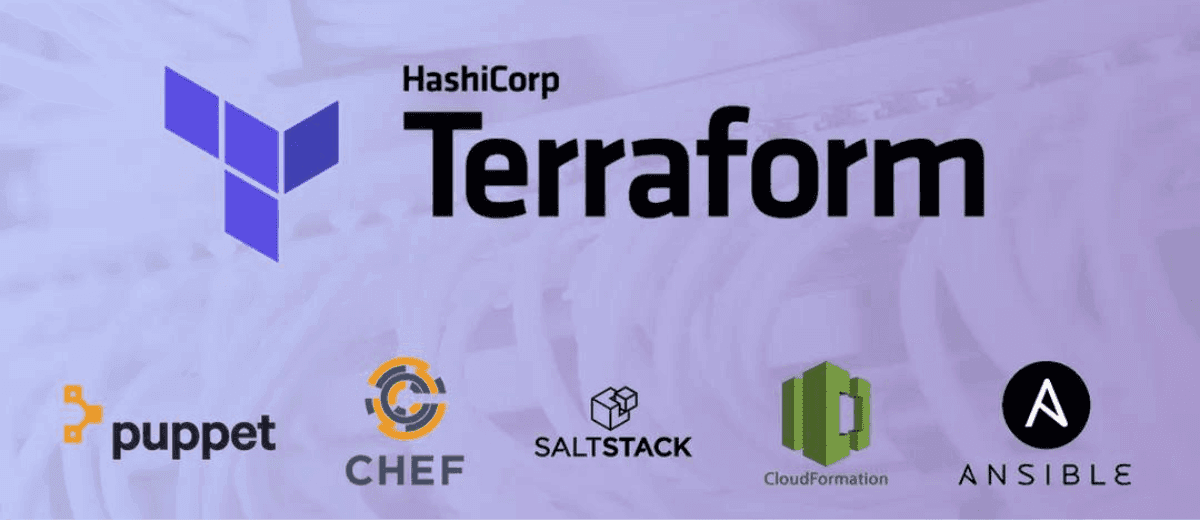- 26th Dec, 2024
- Aarav P.
Unveiling the Power of Terraform: A Beginner’s Guide
28th Mar, 2024 | Dhyey B.
- Software Development

Image source: Terraform
Terraform is an open-source Infrastructure as Code (IaC) tool developed by HashiCorp. It allows users to define and provision infrastructure using a declarative configuration language.
Instead of manually configuring infrastructure components like servers, networks, and storage.
Terraform enables users to describe their desired infrastructure state in code, which Terraform then interprets and applies to create or modify the actual infrastructure resources.
Why Terraform?
1. Declarative Configuration:
With Terraform, infrastructure provisioning is defined through a declarative configuration language, allowing users to describe the desired state of their infrastructure. This makes it easier to understand, maintain, and modify infrastructure code.
2. Multi-Cloud Support:
Terraform offers unparalleled support for various cloud providers, including AWS, Azure, Google Cloud, and others. This flexibility enables organizations to adopt a multi-cloud strategy seamlessly.
3. Infrastructure as Code:
By treating infrastructure as code, Terraform enables automated, repeatable infrastructure deployments. This approach enhances collaboration, reduces human error, and promotes agility in the development process.
4. Resource Graph:
Terraform utilizes a dependency graph to determine the order in which resources are provisioned, ensuring optimal execution and efficient utilization of resources.

Image source: Why Use Terraform?
Comparison of Terraform with Other IaC Tools:
While Terraform shines in many aspects, it's essential to understand how it stacks up against other popular IaC tools like Ansible, Puppet, and Chef.
1. Terraform vs. Ansible:
Unlike Ansible, which follows an imperative approach, Terraform embraces a declarative syntax. While Ansible is primarily focused on configuration management, Terraform specializes in infrastructure provisioning and orchestration.
2. Terraform vs. Puppet/Chef:
Puppet and Chef excel in configuration management and automation but are not dedicated infrastructure provisioning tools. Terraform, on the other hand, is purpose-built for defining, managing, and versioning infrastructure.
Basic About Terraform:
Terraform operates through both a Command-Line Interface (CLI) and a Cloud-based platform, offering users the flexibility to choose based on their requirements.
1. CLI Based:
Terraform's CLI provides a robust set of commands for creating, modifying, and destroying infrastructure. Users can define their infrastructure in Terraform configuration files (usually written in HashiCorp Configuration Language or HCL) and execute commands to apply those configurations to their cloud environment.
2. Cloud Based:
Terraform Cloud is a hosted service provided by HashiCorp, offering collaboration, governance, and automation features for Terraform workflows. It provides a centralized platform for managing infrastructure as code, including version control, execution plans, and state management.
Terraform Architecture

Image source: Terraform Architecture
Basic Command of Terraform
1. terraform init:
This command initializes a Terraform working directory by downloading provider plugins and modules specified in the configuration files (main.tf, variables.tf, etc.). It's typically the first command you run when starting a new Terraform project or when adding new dependencies.
2. terraform plan:
This command generates an execution plan showing what Terraform will do when you apply the configuration. It compares the current state of the infrastructure with the desired state defined in the configuration files and outlines the actions required to reach the desired state.
3. terraform apply:
This command applies the changes required to reach the desired state defined in the configuration files. It provisions, modifies, or deletes resources based on the execution plan generated by terraform plan.
4. terraform destroy:
This command destroys all resources defined in the Terraform configuration files, effectively tearing down the infrastructure provisioned by Terraform.
5. terraform validate:
This command validates the syntax and structure of Terraform configuration files without executing them. It checks for errors, warnings, and deprecated features in the configuration.
6. terraform state:
This command allows you to inspect and modify Terraform's state file, which tracks the state of managed infrastructure and resources.
7. terraform fmt:
This command formats Terraform configuration files according to the Terraform language style conventions, ensuring consistent and readable code.
Terraform Workflow

Image source: Terraform Workflow

Image source: Terraform Work Structure
Terraform Cloud vs. Terraform CLI Workspaces:
While both Terraform Cloud and Terraform CLI Workspaces serve as environments for managing infrastructure configurations, they cater to different use cases.
1. Terraform Cloud:
-
Centralized Collaboration: Terraform Cloud facilitates seamless collaboration among team members by providing shared workspaces, version control, and access controls.
-
Automation and Governance: It offers automation features like remote execution, policy enforcement, and Sentinel integration for ensuring compliance and governance.
-
Scalability: Terraform Cloud scales effortlessly to accommodate growing infrastructure needs, making it ideal for large-scale deployments and enterprise environments.
2. Terraform CLI Workspaces:
-
Local Development: Terraform CLI Workspaces are suitable for individual developers or small teams who prefer local development environments. Developers can use their local CLI to manage infrastructure configurations.
-
Lightweight Projects: For smaller projects or proof-of-concept implementations, Terraform CLI Workspaces offer a lightweight solution without the overhead of a cloud-based platform.
-
Customization: Users have more control over their development environment, including custom tooling, plugins, and integrations.
Reference:
More blogs in "Software Development"
- 6th Mar, 2025
- Rahul C.
How to Develop an OTT Platform: A Complete Guide
- 20th Dec, 2024
- Vikram M.
Cost to Build an AI Trading App Like Thinkorswim: 2025
Join our Newsletter
Get insights on the latest trends in technology and industry, delivered straight to your inbox.









